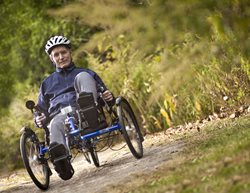About Us
 Thirty years ago, cardiac stents, implantable defibrillators, and programmable pacemakers changed the treatment of cardiac diseases and improved survival rates for patients with heart and vascular conditions. Today, advances in neuromedicine, both in our understanding of fundamental mechanisms of disease and application of technology have placed us at the dawn of another revolution that can restore function to individuals with neurological disabilities which likely will become the number one cause of disability in the U.S.
Thirty years ago, cardiac stents, implantable defibrillators, and programmable pacemakers changed the treatment of cardiac diseases and improved survival rates for patients with heart and vascular conditions. Today, advances in neuromedicine, both in our understanding of fundamental mechanisms of disease and application of technology have placed us at the dawn of another revolution that can restore function to individuals with neurological disabilities which likely will become the number one cause of disability in the U.S.
The University of Rochester is prepared to launch a new initiative called the University of Rochester Neurorestoration Institute (URNI) that will bring together the highest quality and most innovative approaches to restore function in individuals who have suffered damage to their nervous system. Our vision is to create a nationally recognized center for rehabilitation focused on restoration of cognitive, motor, and sensory function. The URNI will offer a comprehensive and integrated set of clinical services and clinical trials for patients, focusing on post-acute and chronic care by offering state-of-the-art therapies that facilitate the restoration of nervous system function. Read about Dr. Brad Berk and the birth of the URNI in Rochester Medicine: Brad Berk’s Next Big Adventure.
The URNI will establish five centers of excellence initially for innovative clinical care and research:
- Medical devices including:
- Medical imaging technologies
- Locomotion (exoskeletons), gait-assisted harness systems, and 3-D analysis
- Adaptive devices to facilitate daily function, exercise, and sports
- Robots for hands, arms, and ankles that improve coordination and strength in a quantitative manner.
- Research will develop robots that use artificial intelligence to interact with patients in real time for both therapy and daily function.
- Pain – drugs, devices, integrative medicine
- Therapeutic nerve blocks – local anesthetic injections given near a specific nerve or group of nerves to relieve pain
- Spinal drug delivery systems – a computerized pump that delivers pain medication continuously into the spine to control intractable pain
- Spinal cord stimulation – a small implantable device that stimulates the spinal cord to treat pain and improve circulation
- Intradiscal electrothermal therapy – treats chronic pain originating from the intervertebral discs
- Transcutaneous electrical nerve stimulation (TENS) – a small external device that delivers electric impulses to nerve endings to stop pain
- Acupuncture – a medical practice which involves inserting fine needles into the skin at specific points in the body to relieve chronic pain
- Psychological counseling
- Stem cells – transplant and novel drugs
I have made significant progress by combining traditional Chinese medicine and techniques (specifically massage, manipulation, meditation, and acupuncture) with typical American physical therapy to achieve my goals. These therapies have enabled me to harness the power of my mind to recover body functions.
~Dr. Bradford Berk
- Explore the use of stem cells to repair damage in the nervous system
- Identify drugs that mobilize and differentiate stem cells for repair of the nervous system
- Neural plasticity – sensory (vision, hearing, smell, touch, taste) and motor restoration
- Sensory substitution, such as creation of auditory representations of the environments for those with visual deficits
- Combined use of imaging, drugs, and robots to restore locomotion
- Integrative medicine – acupuncture, chiropractic, hypnotherapy, massage therapy, mindfulness, nutrition, spiritualism, tai chi, yoga
Foundation of Excellence
The University of Rochester is one of the nation’s leading centers for research and patient care in the field of neuromedicine. Our researchers developed many important insights into the cellular and molecular underpinnings of neurological disorders. Examples include:
- New approaches to the treatment of muscular dystrophy
- Cloning of the gene for facioscapulohumeral dystrophy
- Identification of the glymphatic system as a novel way to remove waste from the brain
- Fundamental insights into the role of sleep and behavior in cognitive function
- Fundamental insights into stroke and management of neural damage following stroke
- New approaches to the diagnosis and treatment of Alzheimer’s and Parkinson's disease
University of Rochester has been the coordinating center for a global network of scientists and clinicians seeking new treatments for neurological diseases. URMC is also home to a comprehensive set of clinical services for both common and rare neurological diseases. There are multiple teams of highly trained providers dedicated to the treatment of life-threatening conditions, such as stroke, brain cancer, spinal cord injury, and traumatic brain injury.
These strengths and history of scientific and clinical excellence have positioned URMC for the next phase of innovation. The URNI will bring together clinicians, scientists, and engineers to create a new generation of medical devices, drugs, and diagnostic technologies, which will improve the lives of people suffering from damage to their brain, spinal cord, and peripheral nervous system.